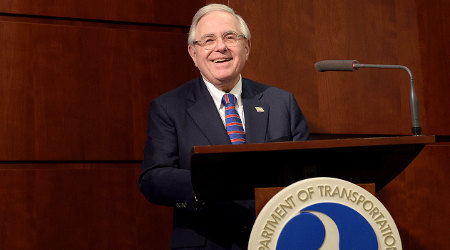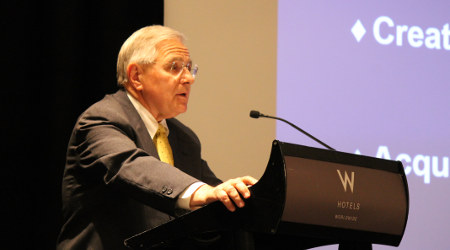Stay updated on news, articles and information for the rail industry
September 2018
Rail News: People
Collaborative approaches, technological advances top Batory’s agenda at the FRA

By Jeff Stagl, Managing Editor
In late 2016, Ron Batory was planning his retirement from Conrail. Come some point in early 2017, he was ready to start the good life after more than 20 years of service at the short line — including 13 as president and chief operating officer — and more than 45 years in the rail industry.
But something happened at 8:45 p.m. on Nov. 14, 2016, a chance encounter so life-changing Batory remembers the exact moment it occurred. He was surfing the internet and came across incoming President Donald Trump’s “Make America Great Again” website, which aimed to recruit people who were interested in helping the new administration. By filling out an online form, interested parties could explain what position they could fill, why they were qualified for it and how they could contribute.
Batory, 68, made a pitch to become the 14th federal railroad administrator. He had dealt with the Federal Railroad Administration (FRA) his entire railroading career.
“So I thought: Why not offer myself up? There was no downside,” says Batory. “There was only upside, and here’s the reason why: I have 46 years of experience that I didn’t get by myself — I got it from thousands of people in the rail industry. If I got approval for this, I could give back to all of those people.”
He wasn’t contacted about his online form for a number of months, but then received phone calls and emails from administration officials asking if he was still interested in the position. After he retired from Conrail on April 1, 2017, he was vetted by the administration from May to July. On July 10, 2017, President Trump announced his intent to nominate Batory as FRA administrator, and the confirmation process began shortly afterward in the Senate.
Then last November, administration officials asked Batory to serve as a senior adviser to U.S. Transportation Secretary Elaine Chao. He came to the U.S. Department of Transportation in Washington, D.C., on Nov. 20 and served in that role until he was confirmed as administrator on Feb. 13, 2018.
Batory believes administration officials were swayed by his more than two-decade stint at Conrail, where he worked for its two owners, CSX and Norfolk Southern Railway. The unusual business arrangement — dealing with competing Class Is — helped him learn to be more fair and impartial in decision-making, and not only assume one position on issues, he says.
“I have institutional knowledge, can be objective and fact-based, and color blind to subject matter,” says Batory. “I am human, so I have my own perspectives, but I stick to trying to be objective.”
His knowledge and perspectives were molded by many other experiences in railroading — a hardworking industry his father, a New York Central Railway car checker, believed wasn’t best suited for a college graduate. But after earning a business degree in 1971 at Adrian College in Adrian, Michigan, Detroit native Batory was drawn to the industry anyway. His first job was a traveling auditor in freight-car accounting for the Detroit, Toledo and Ironton Railroad Co. (DT&I).
“I’ve always carried a passion to work for a railroad. I was attracted to its massive presence and operating mystic,” says Batory. “I was fueled with endless curiosity to learn something new every day about [what became] my life-long passion.”
He later served DT&I as assistant engineer of track, industrial engineer manager, and director of material procurement and planning. During this period, he earned a masters degree in industrial management at Eastern Michigan University.
After the Grand Trunk Western Railway acquired DT&I in 1980, Batory became a transportation supervisor. He eventually was promoted to trainmaster, terminal manager, district operations manager and director of transportation planning, then left the Grand Trunk in 1987 to become general manager of the Chicago, Missouri & Western Railway.
The most enlightening thing Batory learned post-Staggers Act of 1980 was the value of corporate cultures on both a micro (line of road) and macro (staff) basis, and how they interact toward the maintenance and operation of a railroad, he says.
“It is truly a people business within an organic environment,” Batory says.
When the Chicago, Missouri & Western went bankrupt, he helped sell portions of it to several buyers, including the Southern Pacific Railroad, which eventually hired him in 1989 as a GM. During his SP stint, Batory focused joint labor and management efforts on casualty prevention, service consistency and cost containment, which helped improve operational performance.
He left the SP in 1994 to become president of the Belt Railway Co. of Chicago, then joined Conrail in 1997 as VP of operations. He was promoted to president and COO in 2004.
When the ownership of Conrail was split between CSX and NS in 1997, Batory gained the biggest opportunity in his career to be a change agent, he says. Forming a structure for the new Conrail was first and foremost, but the culture within that evolving structure either could be the status quo or something creative, Batory explains.
“The demographics of the workforce were perfect for transitioning to the latter. I’ve always sought change as a rewarding end to fulfilling any responsibility and associated accountability,” he says. “You can’t fear change. If you do, it becomes a lock on the door that keeps you from entering the unknown side of creative change.”
Now as FRA administrator, Batory is trying to bring all of his know-how and experiences to bear, and is pushing for change as he pursues several objectives. A top priority is bringing a successful closure to positive train control (PTC) implementation by 2020’s end, an effort he calls “PTC 1.0.”
The end of 2018 will mean the federal PTC mandate will have reached a “10-year journey with an end in sight,” but some of the 40 freight and passenger railroads required to install the technology can legally take until 2023 to completely finish implementation, says Batory.

“The first year after 2020 they can run the bugs out of their systems, then interoperability [efforts] with tenant railroads can take even longer,” he says.
As a result, there will several more years’ worth of monitoring and governance for the FRA, including the review of PTC documents that sometimes can number hundreds or even thousands of pages. Although the adoption of PTC is challenging, it will greatly enhance safety and help the rail industry further embrace the technological age, Batory says. And both safety and technology top his agenda.
“We don’t want to get passed up on technology. We need to have more collaboration on it,” says Batory. “As we embark on the first half of the 21st century, technology needs to be aggressively exploited in developing and instituting lower-risk operating and and maintenance practices that can take us to new levels of improved safety, thus improving capacity and efficiency with less variability.”
Earlier this year, Batory helped the FRA solicit public comments on the future of automation in the rail industry. In early May, the agency received a lot of input from industry stakeholders, the public, local and state governments, and other interested parties on the potential benefits, costs, risks and challenges to implementing automated rail operations. In addition, some commenters cited ways to best support the rail industry's development and implementation of new and emerging technologies that can boost safety or enhance efficiencies.
The FRA is trying to provide stakeholders constructive access to both strengthen and broaden the agency’s knowledge base, and develop more proactive relationships, says Batory.
Collaboration also is vital when it comes to grade crossing safety and trespasser prevention, he believes. Data on crossing and highway intersection fatalities between 2012 and 2016 is “thought-provoking,” says Batory. There were 1,019 fatalities at crossings with warning devices but just 425 fatalities at passive crossings with only crossbucks; and 13,916 fatalities at intersections with traffic lights that were more than doubled by 32,237 fatalities at intersections with just stop and yield signs.
“We need to promote and realize more collaboration among public and private rail industry stakeholders spirited towards a safer and sustainable future, such as for grade crossing and trespasser issues,” he says.
His other priorities include continuing to exercise and demonstrate what became a “career-long appetite” for factual data that ultimately can lead to constituted decisions, and formulating more performance-based rulemakings, says Batory.
Performance-based regulations focus on performance, as well as desired results and outcomes. They emphasize what must be achieved rather than how the desired results and outcomes must be obtained.
Like many of his objectives — as well as the decision to become FRA administrator — such rulemakings have considerable upside, Batory believes.
“Properly balanced, the combination of minimum/maximum prescriptive rulemakings and performance-based rulemakings can further reduce risk and improve safety,” he says.


 LRW Honors Amtrak’s Acheson As Railway Woman Of The Year
LRW Honors Amtrak’s Acheson As Railway Woman Of The Year
 From Editor-In-Chief Foran: Of Gender Equity And Inclusion
From Editor-In-Chief Foran: Of Gender Equity And Inclusion
 Spotlight On Some Of Today’s Rail Safety Products
Spotlight On Some Of Today’s Rail Safety Products
 Women of Influence in Rail eBook
Women of Influence in Rail eBook
 railPrime
railPrime



